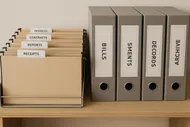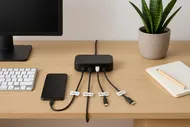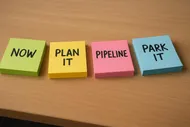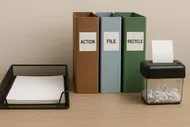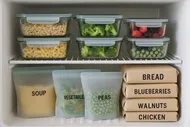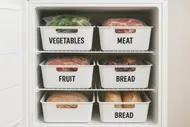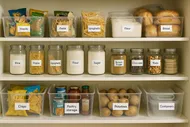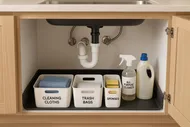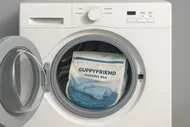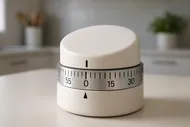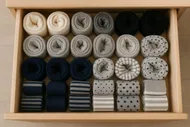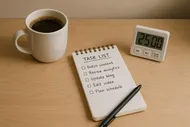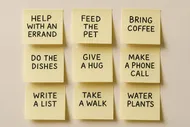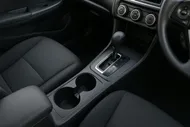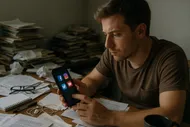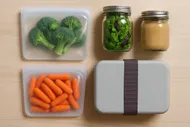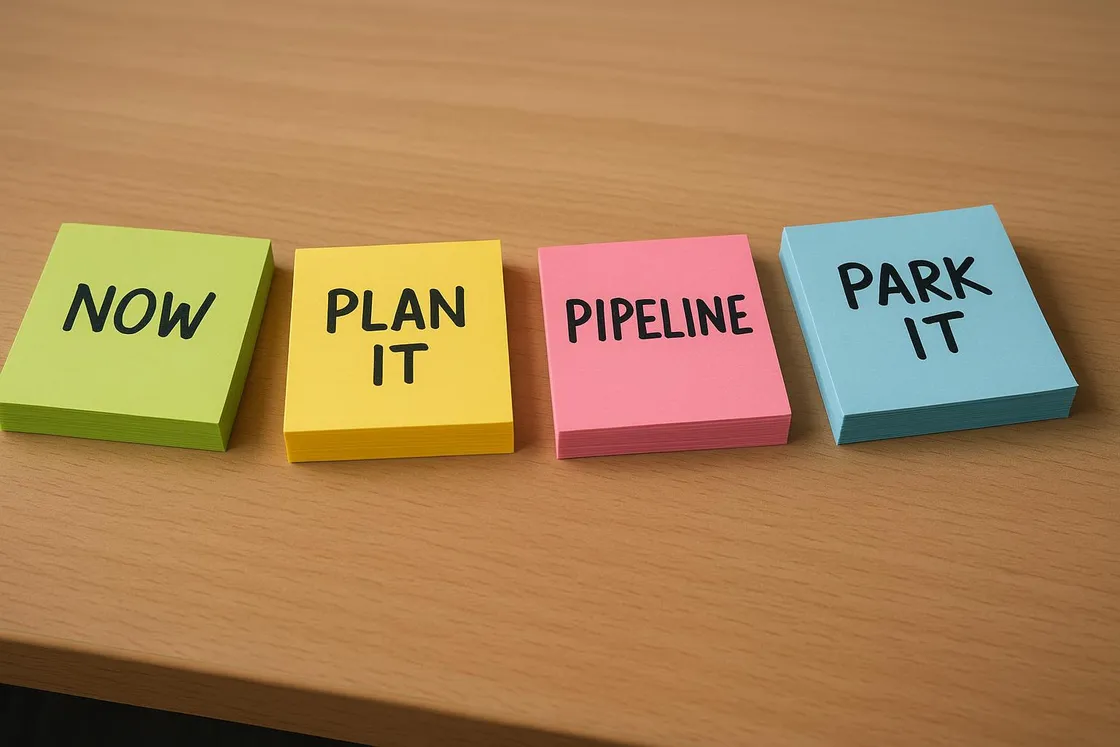
Ever wish your to-do list came with a sorting hat? The Eisenhower Matrix is that hat… except it’s a grid, and grids feel like math class. Good news: you don’t need a grid to use it. In this guide, I’ll show you how to prioritize fast using sticky notes and a few labels. No graph paper, no ruler, and zero shame if your handwriting looks like you used your non-dominant foot.

The Eisenhower Matrix, minus the grid (promise)
The classic idea is simple: separate what’s urgent from what’s important. Urgent things scream. Important things matter. Sometimes they overlap, but often they’re different species entirely. We want to respond to the screams without ignoring the meaningful stuff.
What is important is seldom urgent and what is urgent is seldom important.
Dwight D. Eisenhower
If you like a little backstory, here’s a quick rabbit hole you can definitely stop after two minutes:

But we’re not drawing quadrants today. We’re making four sticky-note piles:
- Now (urgent + important)
- Plan It (not urgent + important)
- Pipeline (urgent + not important)
- Park It (not urgent + not important)
That’s the matrix—but in 3D sticky-note form. It’s like turning spreadsheets into fridge magnets. Somehow way more fun and way less intimidating.
TL;DR Sticky Matrix Cheat Sheet
- Now = Do today. One to three items maximum. If everything is a Now, nothing is.
- Plan It = Schedule it. Protect time on your calendar so it actually happens.
- Pipeline = Delegate, template, or batch. Don’t let these nibble your day to death.
- Park It = Delete, defer, or archive. Future You can revisit during a weekly review.
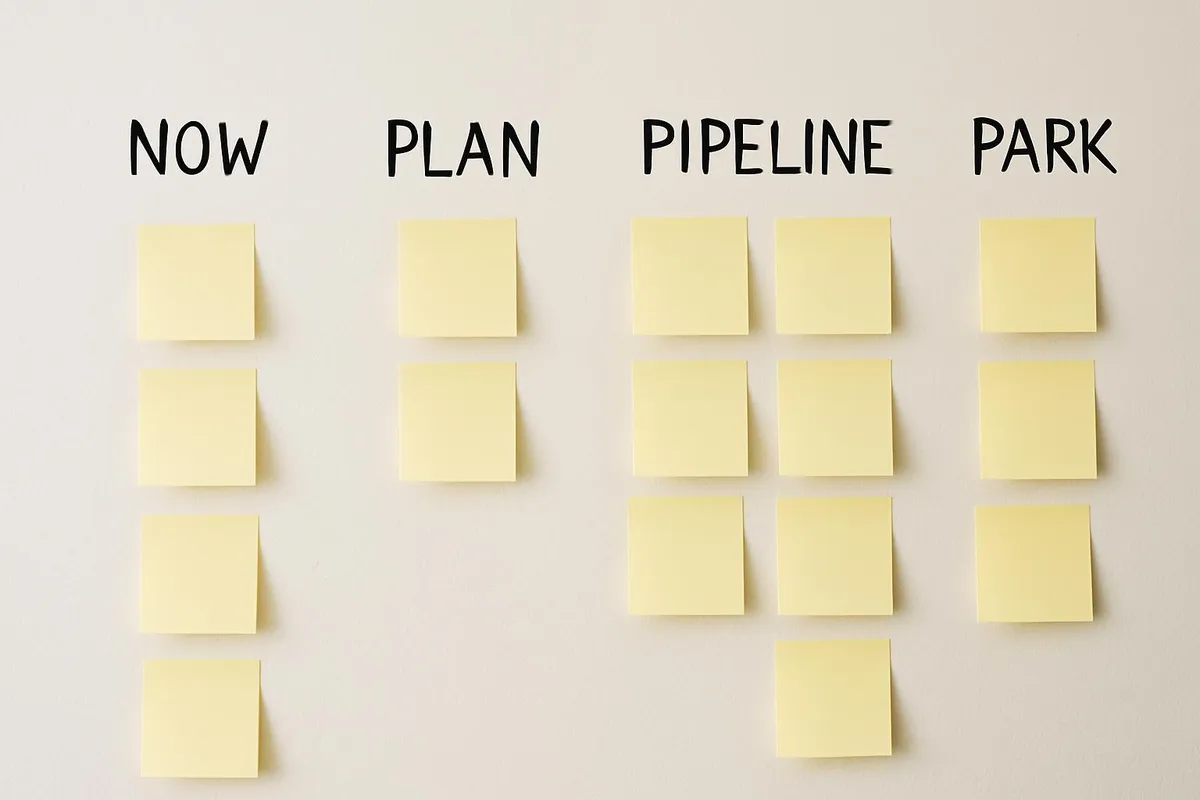
The 10-minute setup (aka: your anti-chaos warmup)
We’re keeping this so low-friction you’ll slide into focus. Set a timer for 10 minutes. If you need a nudge, try the ritual from The 5-Minute Forecast: A Quick Morning Planning Ritual.
- Make the piles
- Grab four index cards or scrap paper. Label them: Now, Plan It, Pipeline, Park It.
- Place them on your desk in a row like runway lights.
- Brain dump the chaos
- Write every open loop on individual sticky notes: one task per note, plain language.
- If it takes more than 60 seconds to write, it’s probably a project. Break it into the first visible step. Need help there? We’ll do “next-action alchemy” in a section below.
- Sort without overthinking
- Drop each note onto one of the four labels. Gut feel. No dithering.
- If you hesitate for more than five seconds, it’s not urgent. Put it in Plan It or Park It.
- Cap the Now pile
- Keep Now at 1–3 items. Beyond that, create a second little column called “Next” but don’t touch it until the first Now is done.
- If this gives you calendar heartburn, see Calendar Cramming: Why Your Time-Blocking Keeps Exploding (And What to Do About It).
- Book your Plan It items
- Put them straight on your calendar. Give them names that start with a verb: “Draft report intro” beats “Report.”
- Defang the Pipeline
- Can you batch these into a Power Hour? Try Mastering the Power Hour for Ultimate Productivity.
- Can you template or delegate? If it’s email, peek at Inbox Triage: The Two-Minute Rule to Email Sanity.
- Can you group them with existing meetings? See Meeting Madness: Surviving (and Silencing) the Calendar Invite Tsunami.



Small gear that helps:
- Sticky notes that actually stick: Amazon search: sticky notes 4x6
- A simple analog timer: Amazon search: Time Timer MOD
- Whiteboard for weekly Park It review: Amazon search: small whiteboard calendar
Next-action alchemy: turn mush into moves
Vague tasks are procrastination bait. “Work on project” is a fog machine. Replace it with an obvious, click-ready next action. Try this quick decision tree:
- If it’s a document: “Create a blank doc named X and outline 3 bullets.”
- If it’s a call: “Message Alex: ‘Can we do 15 min Tue 10:30 or Wed 3:00? Goal: approve budget.’”
- If it’s research: “Collect 3 links and skim intros for relevance.”
- If it’s gnarly: “Write the first ugly draft for 10 minutes. Ugly is allowed, expected, and celebrated.”
Not sure where to start? Pair this with Micro-Habits: Tiny Changes, Huge Gains (And Zero Shame) and give yourself the tiniest possible entry ramp.

Real-life examples (because theory never survived contact with my inbox)
Let’s sort a few common tasks into the four piles:
-
Finish slides for tomorrow’s meeting
- Now. It’s both urgent and important. Set a 25-minute focus sprint. If you’re shaky, try Body Doubling 101: What it is and why it works.
-
Annual strategy review
- Plan It. It’s important but not urgent. Book 45 minutes next week. Protect it with a meeting title that scares reschedules: “Strategy Review – Exec Brief Prep.”
-
Approve 6 expense reports
- Pipeline. Urgent to them, not deeply important to you. Batch for end-of-day and use a checklist. Bonus points for a template response when receipts are missing.
-
Re-arrange icons on your desktop “for focus”
- Park It. That’s a delightful side quest. Save it for your The Shutdown Routine: How 10 Minutes at 5 PM Saves My 9 AM Tomorrow or skip it entirely.
-
Inbox at 2,943
- Pipeline + Plan It hybrid. Run a 20-minute triage with the Inbox Triage: The Two-Minute Rule to Email Sanity playbook. Plan It: schedule a longer cleanup this Friday.
-
Read that big industry report
- Plan It. Schedule 30 minutes to skim and capture highlights. Pro move: copy quotes to your notes app with tags.

Common traps (and how to dodge them gracefully)
- Everything feels urgent
- Symptom: Your Now pile looks like a landfill.
- Fix: Pick a maximum of 3 for Now. Nudge the rest to Plan It. If a stakeholder claims everything is urgent, ask: “If I can only do one by 3 PM, which keeps us unblocked?”
- The Plan It pile becomes a museum of good intentions
- Symptom: Great ideas, dust everywhere.
- Fix: Calendar it immediately. Give each item a “verb + noun” name so it’s obvious what to do when the event starts.
- Pipeline nibble attacks
- Symptom: 19 tiny tasks devour your afternoon like piranhas.
- Fix: Batch similar tasks and time-box them. If you need convincing, read Batching vs. Multitasking: Which Actually Works (And Which Just Feels Like Productivity)?.
- Constant context switching
- Symptom: You touch everything and finish nothing.
- Fix: Try the The One-Tab Challenge: Tame Your Browser Zoo in 7 Days and park unrelated tabs in a read-later list. Keep your Now pile visible and everything else out of sight.
- Park It turns into a black hole
- Symptom: Stuff goes in. Nothing returns.
- Fix: Add a recurring 15-minute Friday review to scan Park It. Delete bravely. If it still matters, promote it to Plan It.
Pro tip
When in doubt, convert everything into a visible next action that starts with a verb. Your future self will thank you when the timer starts and you know exactly what to do.
The One-Week Sticky Matrix Challenge
Want to make this stick (pun fully intended)? Try this for seven days:
Day 1: Set up your four labels and sort everything in sight. Cap your Now at 3. Share your setup to your story and tag us on Instagram so we can cheer you on: https://www.instagram.com/mysimple.life.official/
Day 2: Protect two Plan It blocks on your calendar. Put them in your best energy window. If you don’t know your energy windows yet, run the 7-day experiment in The Energy Budget: Plan Your Day by Batteries, Not Hours.
Day 3: Batch two Pipeline clusters (e.g., approvals + Slack replies). Celebrate with a coffee bribe after.
Day 4: Gut your Park It list. Delete 20% with no regrets. You’ll feel taller.
Day 5: Handle one daunting Plan It item first thing. Use a 25-minute sprint and only open the tabs you need.
Day 6: Do a midday re-sort. Priorities shift. It’s okay to move tasks between piles.
Day 7: Run a 15-minute weekly review. Promote one worthy Park It item, archive the rest, and set your Monday Now list to one thing you’re actually excited to start.

Keep it fun so you’ll actually do it
- Snacks are strategy. No one prioritizes well while hangry. If food helps you focus, try The Snack Break Productivity Method: Can Cookies Fuel Your Success?.
- Sound matters. Some folks love lo-fi; others need silence plus earplugs. Try a white-noise playlist and see how your Now pile melts.
- Make it visible. Arrange your four piles where your eyes naturally land. If you’re mobile, use a notebook spread with four boxes or four digital lists labeled the same way.
Digital version (for people glued to screens)
You can do all of this with your current app. No new software required. But if you want inspiration, check out The Best To-Do List Apps to Trick Your Brain into Getting Stuff Done and then:
- Create four lists or four tags: Now, Plan It, Pipeline, Park It.
- Use “Today” for Now, dated tasks for Plan It, a batched label for Pipeline, and a Someday/Maybe or Archive for Park It.
- On your phone, simplify your home screen so only the task app and calendar are visible. Borrow moves from Turn Your Smartphone into a Minimalist Productivity Tool.
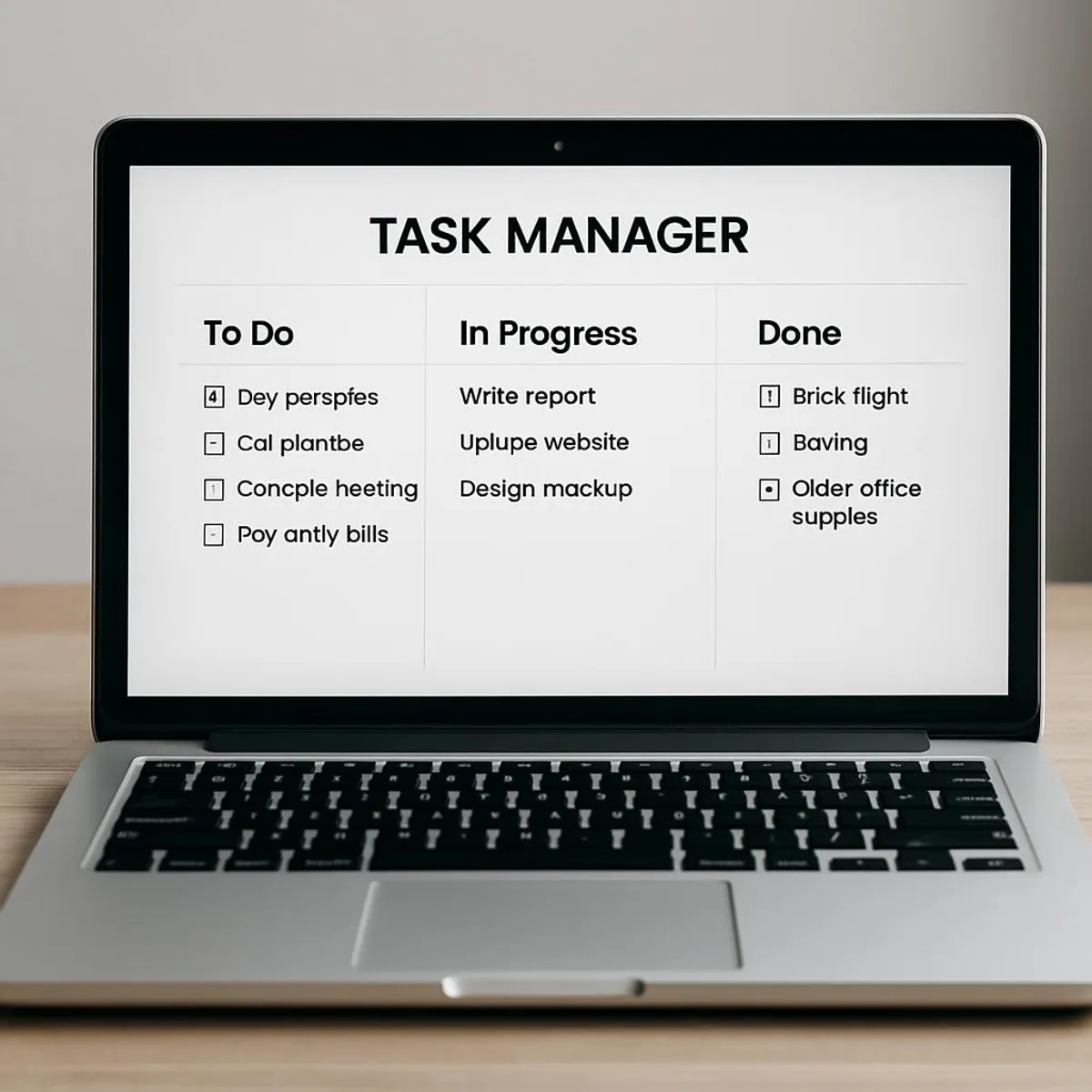
FAQ I get every time I show someone this
-
What if my boss keeps throwing hot potatoes?
- Keep a tiny “parking lot” notepad nearby. Jot new tasks as they pop up. At the next natural break, re-sort. If you need armor for your calendar, use scripts from Meeting Madness: Surviving (and Silencing) the Calendar Invite Tsunami.
-
What if everything is important?
- Only three can be Now. Everything else gets the gift of time on your calendar. Important without time is wishful thinking.
-
What if I sort wrong?
- You’ll re-sort daily. The goal isn’t to be perfect; it’s to be less wrong faster. Progress over perfection, always.
-
How do I handle recurring Pipeline stuff?
- Batch it into a daily or weekly slot and build a mini-checklist so your brain doesn’t have to remember every step.
-
Do I need special supplies?
- Sticky notes, a timer, and a pen are plenty. If you love gear, explore: Amazon search: sticky notes 4x6, Amazon search: Time Timer MOD, Amazon search: small whiteboard calendar.
Make it your own
Rename piles if the default labels don’t click. Try “Do, Date, Delegate, Delete” or “Now, Next, Support, Someday.” The point is clarity. If your labels make you grin, you’ll use them.
A quick daily flow you can steal
- 3 minutes: Scan your four piles, cap the Now pile at 1–3.
- 25 minutes: Sprint one Now item. No tabs, no Slack. If you feel wobbly, try The Art of Productive Breaks: Why Staring Out the Window Might Be Your Secret Weapon between sprints.
- 2 minutes: Log a quick win on a Ta-Da list. If you need motivation, read The Power of the Ta-Da List: Celebrating Small Wins for Big Motivation.
- 5 minutes: Book one Plan It task to your calendar. Protect it like a dentist appointment for your goals.
- 10 minutes at 5 PM: Wrap with your Shutdown Routine. Tidy your piles, set up tomorrow’s Now, and close your browser zoo.

Why this silly little system works
- It forces decisions. Sorting is a choice. Choices kill overwhelm.
- It separates loud from meaningful. The squeaky wheel gets grease, but the wheel that takes you somewhere gets premium oil.
- It’s tactile. Moving a sticky note is weirdly satisfying. Your brain loves visible progress.
- It’s flexible. No grid means you can re-sort in seconds when reality throws a plot twist.
If you’re grid-averse like me, think of this as productivity Tetris without the panic music. You’re not trying to fill every line; you’re arranging pieces so your best work actually lands.
Alright, time to stop reading and start sorting. What’s the first note you’re putting into Now? If you try the one-week challenge, share a pic of your four piles and tag us so I can celebrate your chaos-into-clarity magic: https://www.instagram.com/mysimple.life.official/
And if you want to level up your focus environment first, “procrastination shrine” fans, I’ve got you: Procrastination Shrines: How to Set Up a Workspace You Actually Want to Sit In.
You’ve got this. One sticky note, one smart choice, one satisfying “done” at a time.









